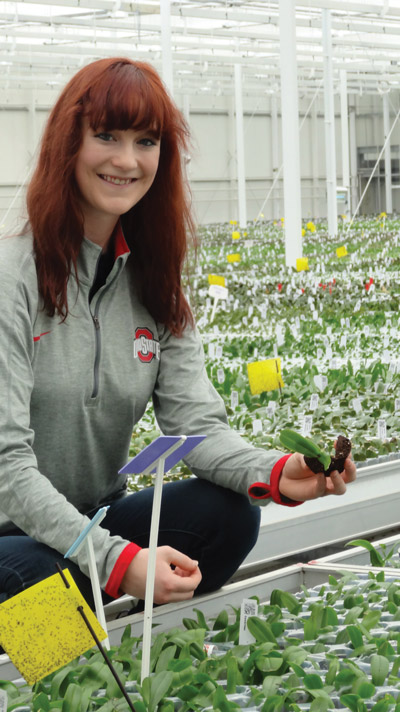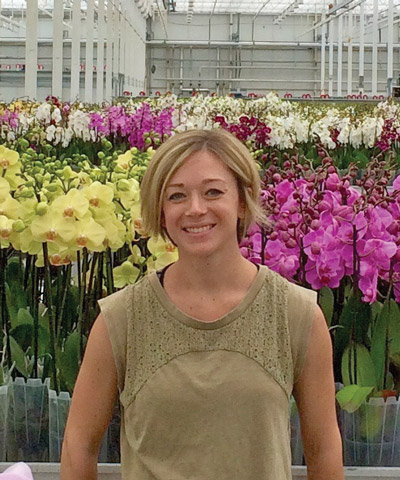12/1/2017
Oh, The Places You’ll Go: Study Abroad in Poland
Allison Westbrook

Abby Wolfe working with orchids at JMP Flowers in Stężyca, Poland. Abby’s internship project focused around dealing with fungus gnat larvae on Phalaenopsis cuttings.

Annie Fulton also interned at JMP Flowers in Stężyca, Poland. Annie worked with their climate control system and implemented a beneficial insect program.
When you read “Poland,” what comes to mind? The food (pierogis and cabbage rolls)? The Old World architecture? How about horticulture?
Some young people attending college are lucky enough to take advantage of the chance to study abroad, most of them choosing to travel to places like England, Spain and France. But Ohio State University students Abby Wolfe and Annie Fulton chose to go to Poland to study horticulture.
Abby and Annie are both majoring in horticulture and minoring in entomology. They had become friends while working for OSU, and when they each received an email about an overseas internship, they decided to take the jump together.
A (Horti)cultural opportunity
The group that organizes and sponsors the internships, The Ohio Group, has opportunities all over the country for students specializing in all different majors. After being chosen for the internship, Abby and Annie spent May 31 to August 7, 2017, working at JMP Flowers, in Stężyca, Poland. JMP Flowers currently produces around 180 varieties of orchids, with 300 or so more varieties in testing, in an area of 10 hectares (nearly 25 acres). They also grow about 70 varieties of anthurium and 70 varieties of roses.
This opportunity was perfect for the girls, as they both envision a future in horticulture. Annie is planning on focusing on greenhouse production, hoping to have her own growing operation one day. Abby is specializing in IPM and would like to go to grad school after a few years in the field.
They were assigned different tasks, working together sometimes, and other times in different areas. Both girls were given assignments that were relevant to their choice of study, reporting to the head grower at JMP.
Annie did plenty of hands-on work in the greenhouse. She says she learned about their climate control system, HortiMaX Synopta, and how to manipulate temperature, humidity and light levels. She also constructed traps for fungus gnats and implemented a beneficial insect program.
Abby mainly worked on a project dealing with fungus gnat larvae on Phalaenopsis cuttings. This involved scouting and using biocontrols, along with chemicals as part of an integrated pest management solution. She also was involved in the use of LED lighting to maintain quality on Phalaenopsis three weeks prior to sale, the crossbreeding of Phalaenopsis Shanghai and a study on the effectiveness of Bonzi in creating more compact Phalaenopsis for shipping and marketing efficiencies.
But it wasn’t all work and no fun for Annie and Abby. Stężyca, where the girls stayed in the company-owned lodging, is about an hour and a half southeast of Warsaw. They worked at JMP during the day, and had free time in the evenings to travel and sightsee. Both had been outside the U.S. before, but this was Abby’s first time in Europe. They made friends at work, who showed them around and introduced them to the area.
When I asked if the girls spoke Polish, Abby replied, “We tried to ...” Luckily, many people in Poland speak English as a second language, so they were able to easily converse with their boss and fellow employees. However, outside the company, many locals weren’t comfortable with English, but the girls learned lots of words and phrases in Polish, and they were able to get by with the help of some friends.
Lessons to take home
So how did this experience contribute to their future in horticulture? Abby noted that it’s always interesting to learn different ways of doing things, which is important in any career.
“We learned a lot of life lessons from the head grower; it was a very worthwhile experience,” she said. Neither had much experience in orchid growing, so this was new for both of them.
Annie notes that the greenhouses were more technically advanced than any they’d worked in before; she said she learned a lot of good tips and tricks.
“I’ve never experienced working with orchids—using the technology that this massive greenhouse had was a really good tool to see and experience. In the future, I think a lot of greenhouses will go more towards that,” Annie said. “I worked quite a bit with their climate control systems, and being a grower, that is very important to learn and use.
“I learned a lot; it was a really good experience.”
Being abroad was a big adventure, and Abby noted, “It was really nice to travel together, to have each other.”
The Ohio International Intern Program (known as The Ohio Program)
Professor Greg Lecki is looking to expand the outbound program, the one that sent Abby and Annie to Poland, to give more opportunities for American students to travel abroad.
In a typical year, there are about 400 inbound students that come into the U.S. for Ag, Hort and Turfgrass programs. Greg has around 160 directly under his supervision. While the inbound program is robust, the outbound student program is smaller and Greg is looking to grow it.
In 2017, there were around 10 U.S. students abroad and he’s hoping to increase that to 20 in 2018. He contributes this discrepancy to the fact that American college students aren’t as used to individual internships abroad as international students might be.
As for the experience a student coming to the U.S. can expect, Greg told us that an individual internship program is prepared for each student that aligns with their education, experience and career path. For example, he says, “A Landscape Design student will be interning in a landscape design or installation company or perhaps in a public garden. A student that wants to take over his father’s crop farm will end up going to a family farm somewhere in Kansas or the Dakotas.”
The Ohio Project works with around 60 countries every year, but over the years, they’ve had students from just over 100 countries. Placements are as diverse as greenhouses, research, plant breeding, public gardens and even animal production. For U.S. students, the benefits to an internship abroad are many: learning about different cultures, experience in their chosen field, networking and discovering the horticulture industry in different countries.
For more information about the internships, contact top@osu.edu. To contact Abby, email her at wolfe.692@buckeyemail.osu.edu, and to contact Annie, email her at affulton@gmail.com. GT